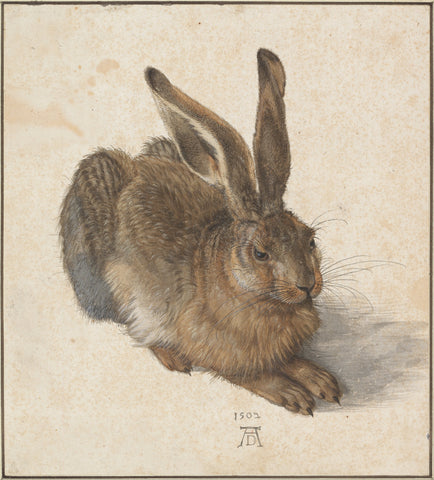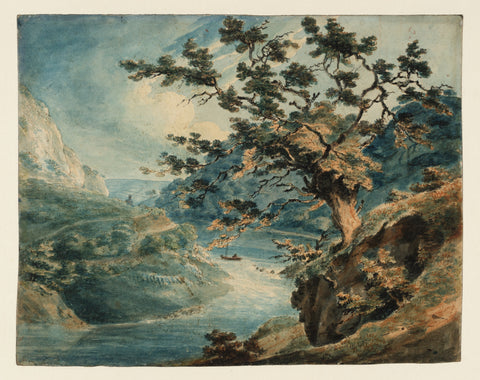Celebrating #WatercolourMonth
Love watercolours? Then this one's for you!
July is Watercolour Month and the perfect opportunity to learn more about the history of watercolour - and to have a go at some art too!
Did you know that one of the most famous paintings in the world is actually a watercolour piece? Young Hare by german artis Albrecht Dürer was created in 1502 and is now being kept in The Albertina Museum in Vienna.
In this blog, we'll take a journey through the history of watercolour, explore the role of England in this art form, discover renowned artists from the past and present, and marvel at some iconic watercolour pieces. So grab your paintbrush (and the obligatory cuppa) and let's get started!
 Young Hare, Painting by Albrecht Dürer, 1502
Young Hare, Painting by Albrecht Dürer, 1502
The use of watercolour dates back centuries - in fact, stone cave paintings from as early as the palaeolithic period were created using charcoal, ochre and other natural pigments! Some of the oldest surviving cave paintings are believed to be over 40,000 years old.
Watercolour first began being used as an art form when ancient civilizations like Egypt and Persia used pigments mixed with water to decorate manuscripts. These early artists laid the foundation for what would become a popular medium.
Throughout the industrial revolution, watercolour became more widely accessible as ready-made paints became available. Before, artists would have to mix their own pigments, which was time consuming. The mass-production brought on by the industrial revolution made watercolours more affordable and accessible to a wider range of artists, including amateurs and hobbyists. Artists could also choose from a wider range of colours, which helped expand their creative possibilities. New papermaking processes were also introduced during this period, which meant paper itself became more widely available!
Today, the accessibility of high-quality materials and the ease of use have made watercolours a popular choice for artists of all levels of experience. Artists are pushing the boundaries of traditional watercolour techniques, experimenting with bold and unconventional approaches. Contemporary watercolour artists are finding innovative ways to combine watercolours with other mediums and techniques. Mixed media approaches, such as combining watercolour with ink, gouache, or collage elements, are becoming increasingly popular. These combinations allow artists to experiment with different textures, layering techniques, and visual effects, pushing the boundaries of traditional watercolour painting.

Joseph Mallord William Turner, View in the Avon Gorge, 1791
England holds a special place in the development of watercolour painting. The English landscape became a key subject matter for watercolourists during the 18th and 19th centuries. Artists such as J.M.W. Turner and John Constable captured the beauty of the English countryside with their loose brushwork and atmospheric effects, solidifying England's reputation as a hub for watercolour artistry.
Winslow Homer, Fishing Boats, Key West,
Watercolour has attracted some of the most talented and influential artists throughout history. William Blake's ethereal and visionary watercolours, J.M.W. Turner's breathtaking seascapes, and Winslow Homer's emotive portrayals of nature are just a few examples of the incredible works that have shaped the watercolour landscape. These artists pushed the boundaries of the medium, experimenting with techniques and capturing scenes that continue to inspire artists today.
The Angels hovering over the body of Christ in the Sepulchre, by William Blake, about 1805, Britain. Some notable contemporary watercolour artists include Larry Bell, Cecily Brown, Don Bachardy, Lourdes Sanchez and Claire Denny.
You can also find some of the country’s best watercolour artists over on the Royal Watercolour Society website.
 The Angels hovering over the body of Christ in the Sepulchre, by William Blake, about 1805
The Angels hovering over the body of Christ in the Sepulchre, by William Blake, about 1805
 David Hockney, Self-Portrait with Red Braces, 2003
David Hockney, Self-Portrait with Red Braces, 2003
Throughout history, certain watercolour pieces have become iconic representations of the medium's beauty and versatility. The Ancient of Days by William Blake, 1794; The Burning of the Houses of Parliament, J. M. W. Turner, 1835 and David Hockney Self-Portrait with Red Braces (2003) are just a few examples that have left a lasting impact on the art world. These masterpieces showcase the technical skill and artistic vision that can be achieved through watercolour.
 The Burning of the Houses of Parliament, J. M. W. Turner, 1835
The Burning of the Houses of Parliament, J. M. W. Turner, 1835
If you fancy having a go at creating watercolour art but don’t know how to get started, our Artful Watercolour Box is a great way to begin! This carefully curated box comes with everything you need to get going, including watercolour half pans, tools, our popular Artful magazine (filled with interviews and tutorials) and more! Find out more here.

